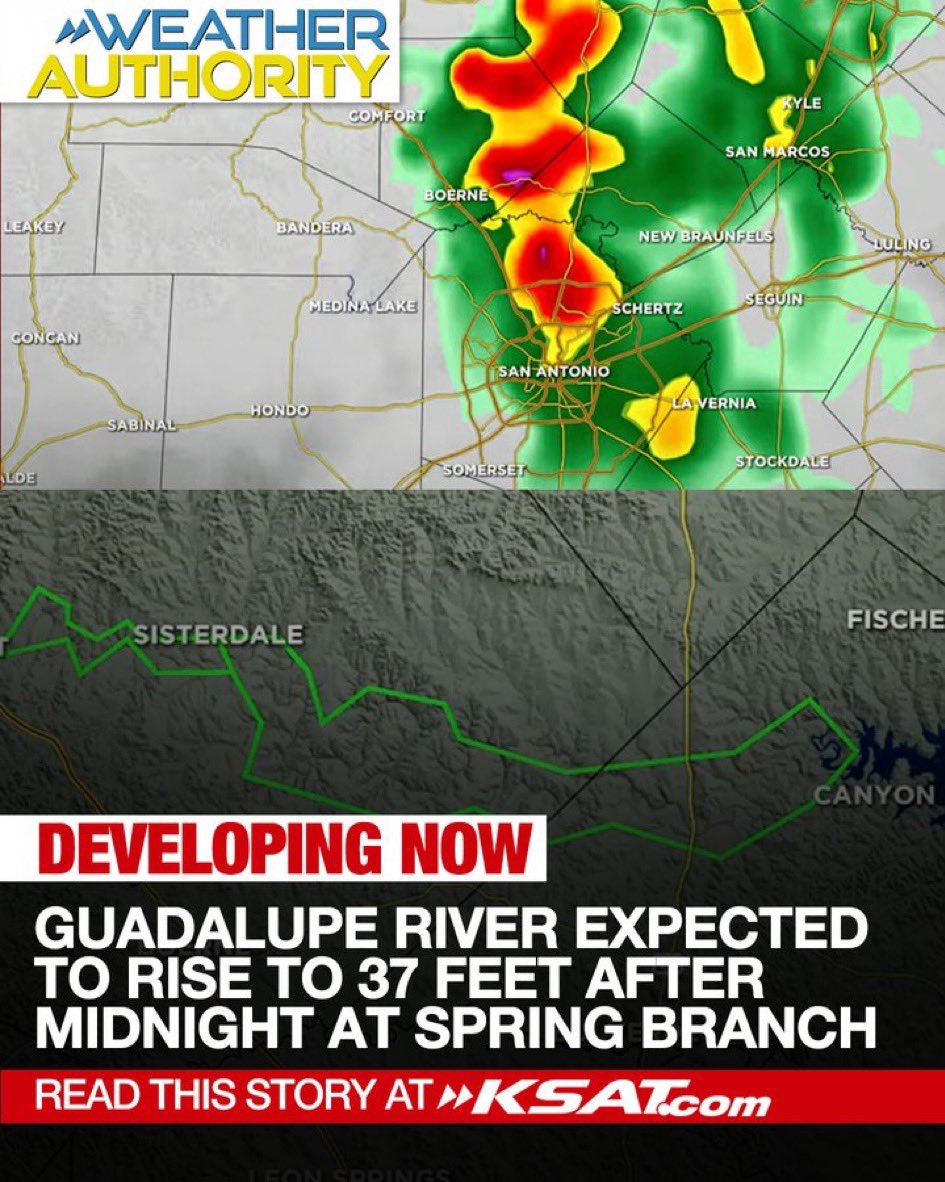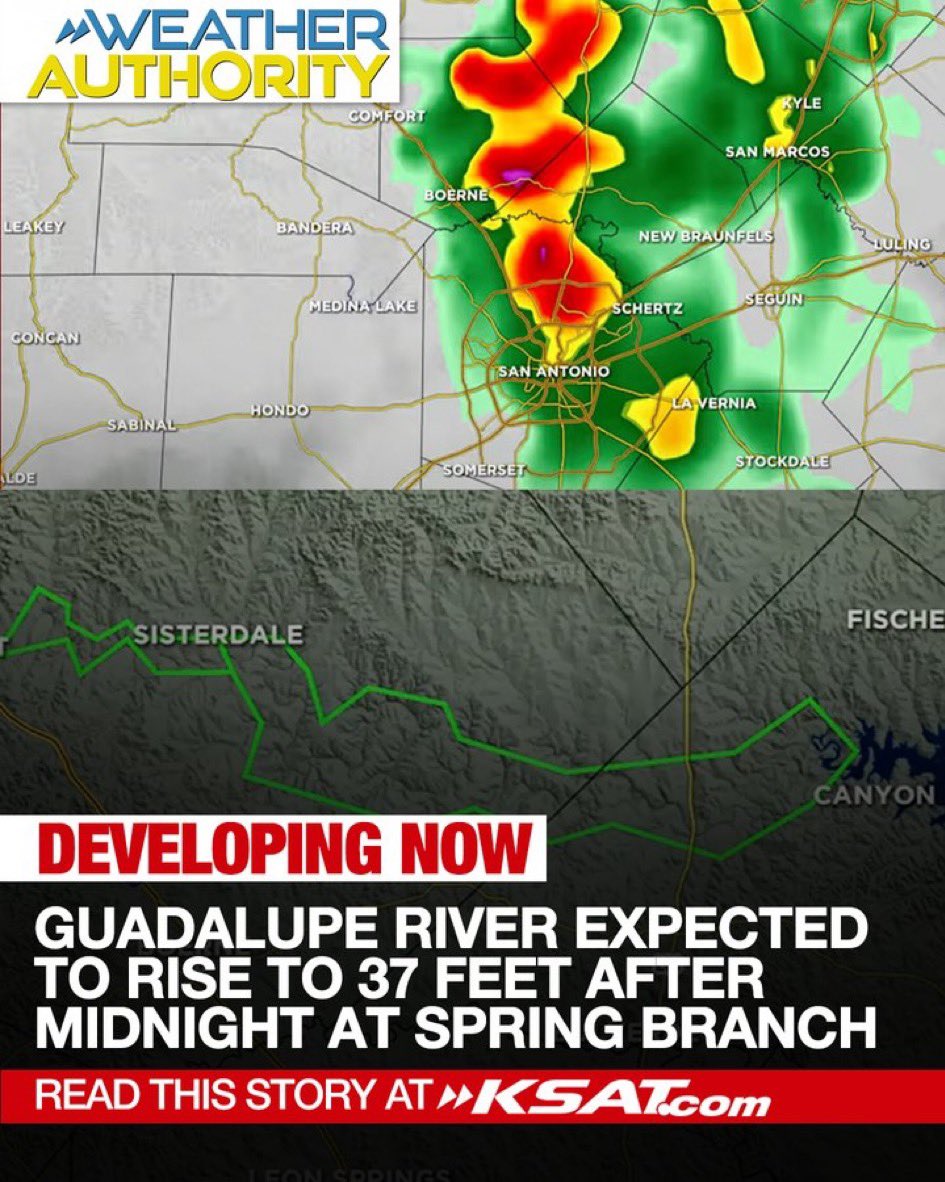Catastrophic Flood Warning: Guadalupe River Set to Surge Past ’98 Levels!
Flood Alert for the Guadalupe River: Critical Information and Safety Measures
Recent weather forecasts have issued a flood alert for the Guadalupe River, with predictions indicating that the river will reach a flood stage of 37 feet by 2 a.m. on Saturday, early morning. This alarming forecast suggests that water levels will rise significantly, potentially covering major roadways, including U.S. Highway 281. Notably, this projected crest is expected to exceed the historical flood levels experienced during the catastrophic Flood of ’98 by a staggering 10 feet.
Understanding the Flood Risks
Floods can develop rapidly and pose serious risks to life and property. The current alert serves as a reminder of the importance of being aware of local weather conditions and the potential impact they may have on the community. It is essential to recognize that heavy rainfall, combined with saturated ground conditions, can lead to swift changes in river levels.
- Historical Context: The Flood of ’98 remains a significant benchmark for flood preparedness. The projected levels for this upcoming event are particularly concerning, as they exceed the historical data recorded during that time. This context emphasizes the need for vigilance and preparedness in the face of potential natural disasters.
Safety Recommendations
In light of the impending flood, local authorities and emergency services are urging residents to take immediate precautions. Here are some critical safety measures to follow:
- Stay Indoors: The most crucial advice during flood warnings is to stay home. Avoid unnecessary travel, especially on roadways that are prone to flooding. U.S. Highway 281 is specifically mentioned as a route that may be affected, and motorists should plan alternative routes if necessary.
- Prepare an Emergency Kit: Having an emergency kit ready can be invaluable during a flood. This kit should include essential supplies such as water, non-perishable food, medications, flashlights, batteries, and important documents.
- Stay Informed: Keep updated with the latest weather reports and alerts from reliable sources. Local news stations and official social media accounts are excellent resources for real-time information.
- Evacuation Plans: If you live in a flood-prone area, have a plan in place for evacuation. Identify safe routes and locations where you can seek shelter, and ensure all family members are aware of the plan.
The Importance of Community Awareness
Community awareness plays a critical role in flood preparedness. Sharing information about the flood alert with neighbors, especially those who may be more vulnerable, can help ensure everyone’s safety.
- YOU MAY ALSO LIKE TO WATCH THIS TRENDING STORY ON YOUTUBE. Waverly Hills Hospital's Horror Story: The Most Haunted Room 502
- Engage with Local Resources: Local authorities often provide resources and guidance during flood events. This may include sandbag distribution points, emergency shelters, and information on road closures. Participating in community preparedness initiatives can also help bolster collective safety measures.
- Social Media as a Tool: Social media platforms, such as Twitter, play a vital role in disseminating information quickly. The tweet from Hernando Arce serves as an example of how social media can be used to alert the public about significant weather events. Following local meteorologists and emergency services accounts can help keep you informed.
What to Expect During the Flood
As the floodwaters rise, it is essential to understand the potential impacts on your area. Flooding can result in:
- Road Closures: As mentioned, U.S. Highway 281 may be submerged, leading to significant traffic disruptions. Be prepared for detours and plan your travel accordingly.
- Property Damage: Higher water levels can lead to property damage, particularly in low-lying areas. Homeowners should take steps to protect their property, such as moving valuables to higher ground and securing outdoor items.
- Health Risks: Floodwaters can pose health risks, including contamination. Avoid contact with floodwater whenever possible, and ensure that you have access to clean drinking water.
Conclusion
The flood alert for the Guadalupe River serves as a critical reminder of the power of nature and the need for preparedness. With the forecast predicting water levels to exceed those of the historic Flood of ’98, residents must take this warning seriously. By staying informed, preparing an emergency kit, and adhering to safety recommendations, individuals can help protect themselves and their families during this challenging time.
As the situation develops, it is vital to remain vigilant and responsive to changing conditions. Remember to prioritize safety over convenience—staying home and following the guidance of local authorities can make all the difference in navigating this potential disaster. Stay safe, and keep an eye on official channels for updates as the situation unfolds.

Flood Alert Tonight : The Guadalupe River is expected to reach flood stage of 37 feet by 2 a.m. on Saturday early morning , which will likely cover U.S. Highway 281. This forecast crest is expected to be 10 feet higher than the Flood of ’98.
Stay home. pic.twitter.com/wVbtwHhVqY
— hernando arce (@hernandoarce) July 4, 2025
Flood Alert Tonight: The Guadalupe River is Expected to Reach Flood Stage of 37 Feet
Hey there! If you’re in the area near the Guadalupe River, you might want to pay close attention. A flood alert has been issued for tonight, and it’s no small matter. The river is projected to hit a flood stage of a whopping 37 feet by 2 a.m. on Saturday morning. That’s right—37 feet! This isn’t just a casual rise; it’s expected to cover U.S. Highway 281, which could impact travel and daily life significantly.
What Does This Mean for You?
So, what exactly does a flood stage of 37 feet mean? Well, it indicates that the river has risen to a level that could cause serious flooding in surrounding areas. In fact, this forecast crest is expected to be 10 feet higher than the infamous Flood of ’98, a flood that many locals still remember vividly. The potential for flooding is real, so it’s crucial to take this warning seriously.
Historical Context: The Flood of ’98
If you’re wondering how significant this forecast is, let’s take a trip down memory lane. The Flood of ’98 was a devastating event that left lasting impacts on the community. Many residents experienced property damage and disruptions in their daily lives. The current forecast suggests that this flood could be even worse. It’s a stark reminder of how powerful nature can be, and it’s something we should all keep in mind as we prepare for the coming hours.
Safety First: Stay Home
The best advice right now? Stay home. Seriously, if you don’t have to be out on the roads, it’s safer to hunker down. The authorities are urging everyone to avoid unnecessary travel, especially on highways like U.S. Highway 281, which could be submerged under water. Staying informed and taking precautionary measures is key during these times.
What Should You Do?
Now that you know a flood alert is in effect, you might be wondering what steps to take. Here are some practical tips to keep yourself and your loved ones safe:
- Stay Updated: Keep an eye on local news and weather updates. Websites like Weather.gov provide current forecasts and warnings.
- Prepare an Emergency Kit: Stock up on essentials like bottled water, non-perishable food, medications, and flashlights. You never know how long you might be without power or access to stores.
- Know Your Evacuation Routes: Familiarize yourself with potential evacuation routes in case the situation worsens. It’s always better to be prepared.
Understanding Flood Alerts and Warnings
It’s essential to understand the different types of flood alerts and what they mean. A flood watch means conditions are favorable for flooding, while a flood warning indicates that flooding is imminent or already occurring. With the Guadalupe River expected to reach a flood stage of 37 feet, we’re definitely looking at a serious flood warning. Staying alert can make all the difference in your safety.
Community Preparedness
In times like these, community support is incredibly important. If you have neighbors, especially those who are elderly or may need assistance, check in on them. A simple phone call or a knock on the door can go a long way in ensuring everyone is prepared and safe. Communities often come together in times of crisis, and this is an excellent opportunity to strengthen those bonds.
After the Flood: What to Expect
Once the storm passes and the waters begin to recede, the cleanup will begin. It’s crucial to assess the damage carefully. If your property has been affected, document everything with photos for insurance purposes. Local agencies will often provide support and resources to help residents recover. Familiarize yourself with local resources or visit FEMA for assistance programs.
Stay Informed: Follow Local Authorities
Make sure to follow local authorities on social media, such as Twitter, for real-time updates. For example, you can check updates from reliable sources like @hernandoarce, who has been sharing critical information regarding the Guadalupe River flood situation. Staying informed is your best line of defense.
Flood Preparedness Resources
If you want to dig deeper and find more resources on flood preparedness, consider checking out websites dedicated to emergency preparedness. The Ready.gov site offers a wealth of information on how to prepare for floods, what to do during one, and how to recover afterward. There’s no harm in being overly prepared—better safe than sorry!
Final Thoughts
Although this flood alert for the Guadalupe River may feel daunting, remember that you’re not alone. Follow the guidelines provided by local authorities, take precautions, and stay updated. The community will pull through, and together, we can navigate this challenging situation. Remember: Stay home, stay safe!
“`

